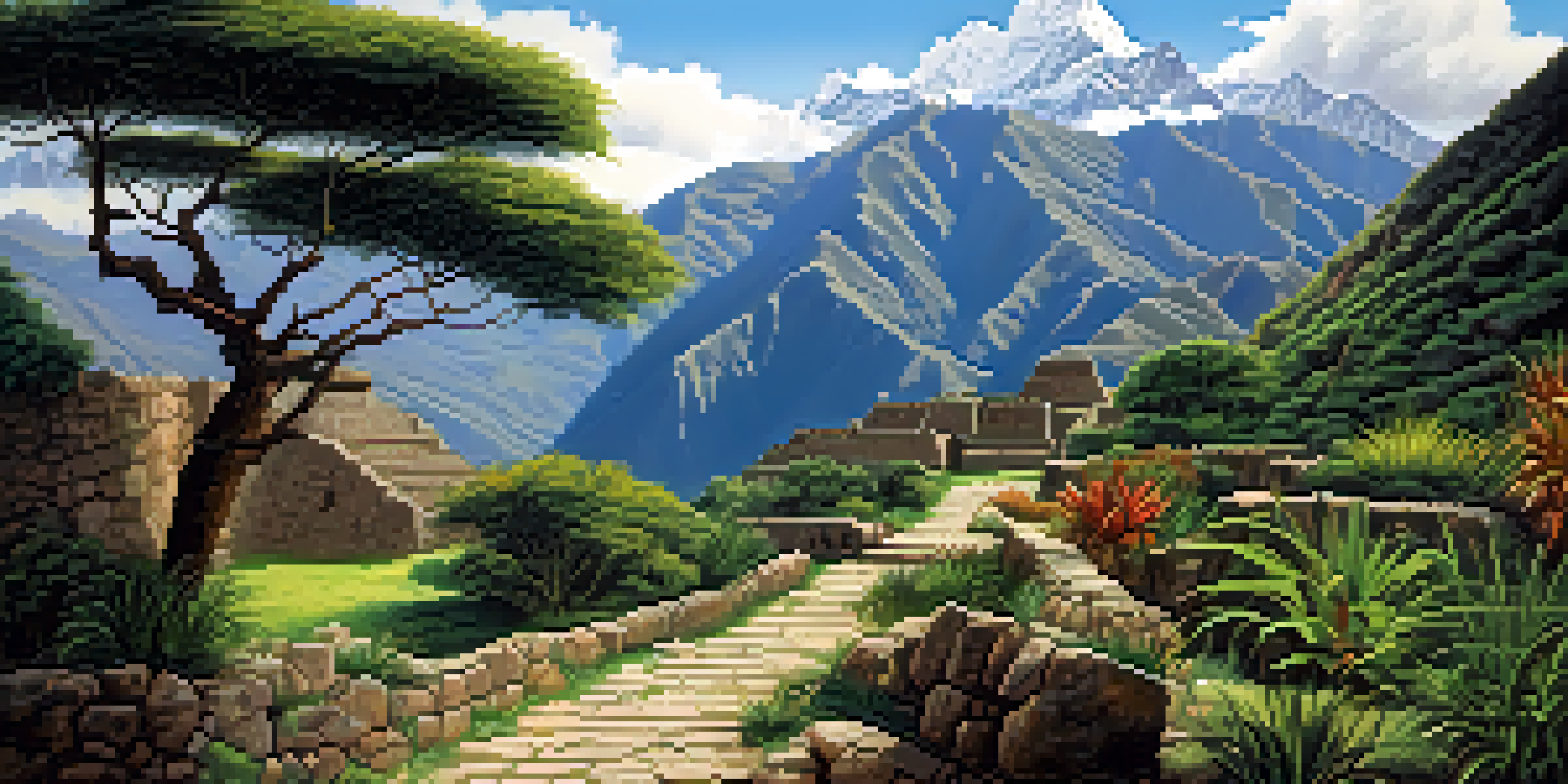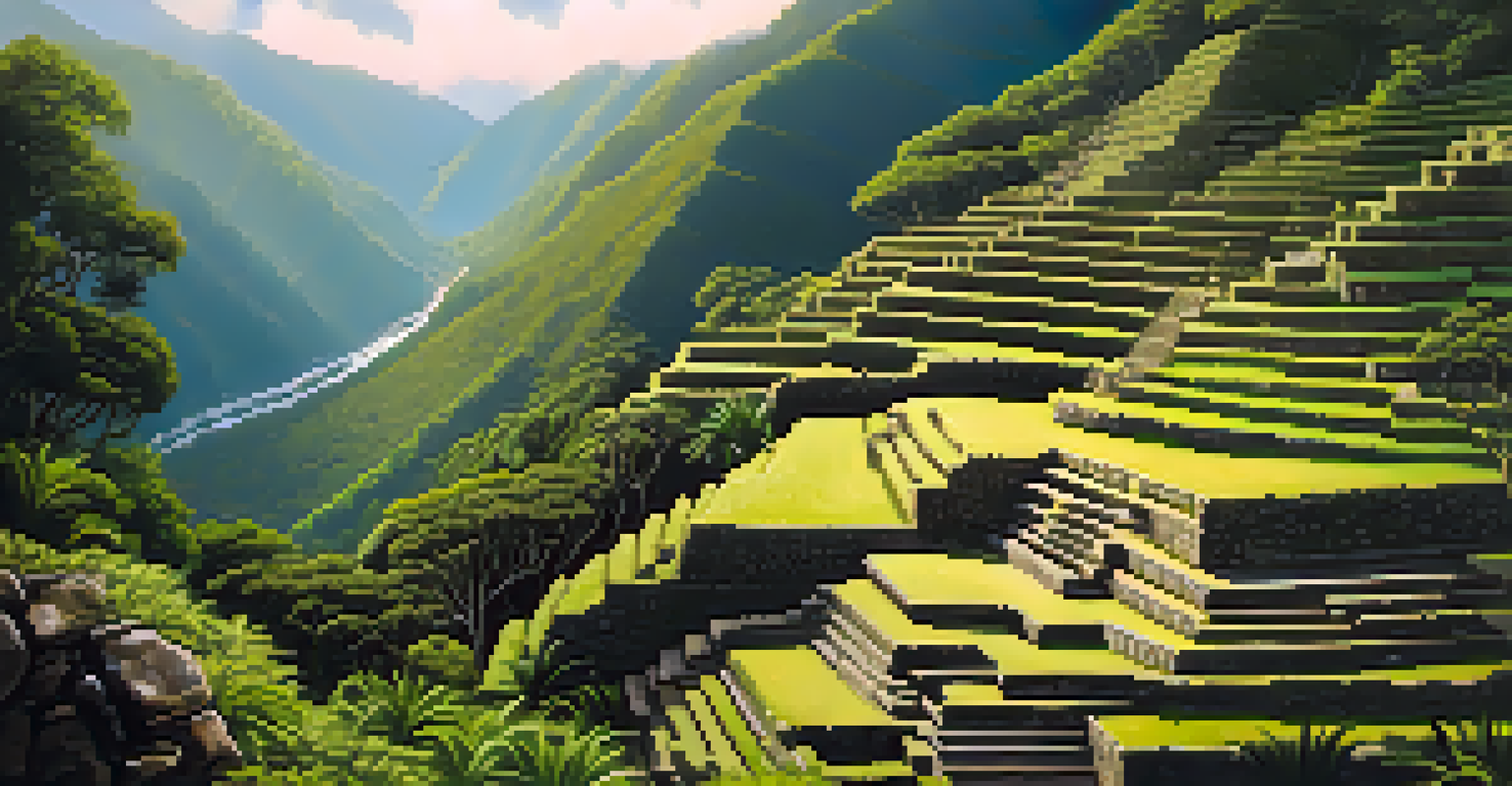The Inca Trail: A Classic Adventure Racing Route

Why the Inca Trail is a Top Adventure Racing Route
The Inca Trail is not just a hike; it's a journey through history and breathtaking landscapes. As you traverse this classic route, you’ll find yourself surrounded by ancient ruins and stunning natural beauty, making it a coveted destination for adventure racers. It offers a unique blend of physical challenge and cultural immersion that few other trails can match.
The journey not the arrival matters.
What sets the Inca Trail apart is its remarkable combination of high-altitude trekking and rich cultural heritage. The path leads you through diverse ecosystems, from lush jungles to arid highlands, all while following the footsteps of the ancient Incas. This diversity keeps adventurers engaged and rewards them with ever-changing scenery and experiences.
Moreover, the sense of accomplishment from completing the Inca Trail is unmatched. Whether you’re an experienced racer or a curious beginner, conquering this trail provides a fulfilling sense of achievement that resonates long after the journey ends. It's an adventure that stays with you, inspiring you to tackle new challenges.
Preparing for the Inca Trail Adventure Race
Preparation is key when it comes to tackling the Inca Trail. First and foremost, physical conditioning is essential, as the trail demands endurance and stamina. Incorporating hiking, cardio, and strength training into your routine will help ensure you're ready to take on the challenges posed by the terrain and altitude.

Additionally, understanding the route and its difficulties is crucial. The Inca Trail spans approximately 26 miles and includes steep ascents and descents, with some sections reaching elevations over 13,000 feet. Familiarizing yourself with the trail layout and potential weather conditions will help you mentally prepare for the adventure ahead.
Physical and Cultural Adventure
The Inca Trail offers a unique combination of high-altitude trekking and rich cultural heritage, making it a coveted destination for adventure racers.
Don’t forget about gear! Investing in high-quality hiking boots and weather-appropriate clothing can make all the difference in your comfort and performance. Packing light but smart is also vital, as you'll need to carry your essentials while navigating through this stunning but demanding landscape.
Understanding the Cultural Significance of the Inca Trail
The Inca Trail is more than just a physical challenge; it’s a trek through a rich cultural tapestry. As you walk, you’ll encounter ancient Incan ruins like Wiñay Wayna and the iconic Machu Picchu, each telling a story of a civilization that thrived in harmony with the land. This historical context adds depth to your adventure, making each step feel significant.
Take only memories, leave only footprints.
Moreover, the connection to local traditions is palpable along the trail. Indigenous communities continue to inhabit the region, and their customs can be seen in the way they interact with the land and travelers. Engaging with locals can provide a deeper understanding of their way of life, enhancing your overall experience.
Lastly, respecting and preserving the cultural heritage of the Inca Trail is paramount. As adventurers, it's our responsibility to leave no trace and honor the sites we visit. This not only ensures the trail remains pristine for future generations but also fosters a sense of respect and appreciation for the rich history embedded in every stone along the path.
Highlights of the Inca Trail: Must-See Spots
One of the most captivating aspects of the Inca Trail is the breathtaking views that await around every corner. Key highlights include Dead Woman's Pass, the highest point on the trail, where the panorama of the Andes Mountains is simply awe-inspiring. It’s a perfect spot for a well-deserved break, offering stunning vistas that make the climb worthwhile.
Another must-see is the archaeological site of Wiñay Wayna, a stunning complex that showcases the ingenuity of the Incas. Nestled amidst lush greenery, the terraces and structures are a testament to the civilization's advanced agricultural practices. Stopping here allows for a moment of reflection on the ingenuity of those who walked the same paths centuries ago.
Essential Preparation Tips
Proper physical conditioning, understanding the trail's challenges, and investing in quality gear are crucial for a successful Inca Trail adventure.
Finally, no journey is complete without reaching Machu Picchu itself. The moment you catch your first glimpse of this iconic site, you’ll understand why it’s considered one of the Seven Wonders of the World. Standing in the midst of this ancient citadel, surrounded by the rugged beauty of the Andes, is an experience that truly encapsulates the magic of the Inca Trail.
Tips for a Successful Inca Trail Adventure Race
To maximize your enjoyment of the Inca Trail, consider pacing yourself. With a variety of terrains and altitudes, it’s crucial to listen to your body and take breaks when needed. This not only helps with stamina but also allows you to soak in the beautiful surroundings, making your journey all the more rewarding.
Hydration is another essential factor. The altitude can dehydrate you quickly, so it's important to drink water regularly. Carrying a reusable water bottle and using purification tablets or filters can help you stay hydrated without adding too much weight to your pack.
Lastly, embrace the journey! While reaching Machu Picchu is a significant milestone, the experiences and memories you create along the trail are just as important. Take time to appreciate the small moments, whether it’s sharing stories with fellow hikers or marveling at the vibrant flora and fauna along the way.
The Best Time of Year to Take on the Inca Trail
Timing your adventure on the Inca Trail can greatly enhance your experience. The dry season, from May to September, is generally considered the best time for trekking, offering clear skies and milder temperatures. This is especially crucial for those looking to race, as slippery trails can add unnecessary challenges.
However, it's worth noting that this period can also attract larger crowds. If you prefer a more serene experience, consider the shoulder months of April or October. During these times, the weather can still be favorable, and you'll likely encounter fewer travelers along the route.
Respect Cultural Heritage
Engaging with local traditions and preserving the trail's cultural significance is essential for honoring the rich history of the Inca civilization.
Regardless of when you choose to go, being prepared for varying weather conditions is essential. Even during the dry season, temperatures can drop at night, so packing layers is key. Being adaptable will ensure you enjoy the adventure to its fullest, no matter the season.
Conclusion: Embrace the Adventure of the Inca Trail
The Inca Trail is a classic adventure racing route that promises not just physical challenge but also deep cultural engagement. With its stunning views, rich history, and vibrant ecosystems, it’s an experience like no other. Whether you're a seasoned racer or a first-time adventurer, this trail offers something for everyone.
As you prepare for your journey, remember to respect the land and its history, ensuring that future generations can enjoy the same breathtaking experiences. Embrace the journey, challenge yourself, and savor every moment spent on this iconic trail.

Ultimately, the Inca Trail is more than just a race; it's a pathway to self-discovery and connection with the world around you. So lace up your boots, pack your gear, and get ready for an unforgettable adventure through one of the most remarkable trails on the planet.